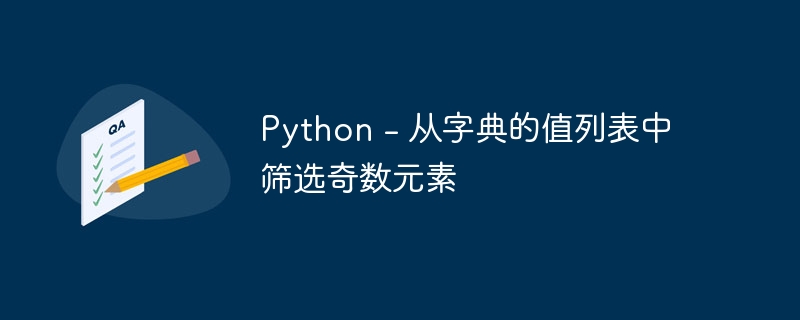Python - 從字典的值列表中篩選奇數元素

字典是Python中一種流行的資料類型,它有一個鍵值對,並且不允許重複。為了過濾奇數元素,它有一些內建函數,例如 items()、filter()、lambda,並且 list() 將用於從字典中的值列表中過濾奇數元素。列表中的奇數元素是那些不能被 2 整除的元素。
例如 -
給定列表,[10, 22, 21, 19, 2, 5]
從列表中過濾奇數元素後:
最終結果變成[10, 22, 2](這些是能被整數2整除的元素)。
文法
範例中使用以下語法 -
items()
這是一個內建方法,可用來傳回視圖物件。該物件由帶有值對的鍵組成。
filter()
Python的filter()元素用於根據特定條件過濾元素。
lambda
函數 lambda 提供了使用 lambda 關鍵字宣告簡短匿名函數的捷徑。當使用 def 關鍵字聲明時,lambda 函數會起作用。
list()
list() 是內建的 Python,它會建立列表對象,它接受可迭代構造並將其轉換為列表。
x % 2 != 0 or x % 2 == 1
上述兩種表示都說明了從值列表中過濾奇數元素的邏輯。
透過 if-else 語句使用字典理解和列表理解
程式使用字典理解,透過過濾奇數元素將原始字典轉換為新字典。可以透過使用 if-else 語句的列表壓縮來過濾這個奇怪的元素。
範例
在以下範例中,使用名為odd_element 的函數啟動程序,該函數接受名為dictionary 的參數。相同的參數與理解技術一起使用,即 list 和 dictionary 以及 if-statement 來設定值列表中奇數元素的過濾器字典。然後建立字典的值清單並將它們儲存在名為 dictionary 的變數名稱中。接下來,使用呼叫函數並將參數名稱作為字典傳遞,其中包含鍵值對並將其儲存在變數 filter_dict 中。最後,我們在變數filter_dict的幫助下列印結果。
def odd_elements(dictionary):
return {key: [x for x in value if x % 2 != 0] for key, value in dictionary.items()}
# Create the dictionary
dictionary = {'A': [2, 4, 16, 19, 17], 'B': [61, 71, 90, 80, 10], 'C': [11, 121, 13, 14, 15]}
filter_dict = odd_elements(dictionary)
print("Filter odd elements from the value lists in dictionary:\n", filter_dict)
輸出
Filter odd elements from the value lists in dictionary:
{'A': [19, 17], 'B': [61, 71], 'C': [11, 121, 13, 15]}
將 for 迴圈和 Filter() 與 Lambda 函數結合使用
程式使用 for 迴圈,將使用內建方法 items() 迭代字典項目的鍵和值。然後它將使用嵌套的內建函數(如 list()、filter() 和 lambda)從字典列表中刪除奇數元素。
範例
在下面的範例中,我們將使用 for 迴圈來迭代變數字典,其中包含帶有值列表的鍵。為了過濾奇數元素,它將使用三個嵌套的內建函數,即list()、filter() 和lambda()[此函數將條件設為x%2 != 0,它將檢查給定值列表是否為整數是否能被2整除]並將其儲存在變數filtered_dictionary中。過濾奇數元素後,將filtered_dictionary的值設定在filtered_dictionary中。然後創建由鍵和值列表組成的字典並將其儲存在變數字典中。現在這個變數設定在呼叫函數 odd_element() 的參數中,並儲存在變數 filter_dict() 中。
def odd_elements(dictionary):
filtered_dictionary = {}
# for loop
for key, value in dictionary.items():
# Using filter() with lambda
filtered_values = list(filter(lambda x: x % 2 != 0, value))
filtered_dictionary[key] = filtered_values
return filtered_dictionary
# create the dictionary
dictionary = {'A': [1, 2, 3, 4, 5], 'B': [6, 7, 8, 9, 10], 'C': [11, 12, 13, 14, 15], 'D': [16, 17, 18, 19, 20]}
filter_dict = odd_elements(dictionary)
print("Filter odd elements from the value lists in dictionary:\n", filter_dict)
輸出
Filter odd elements from the value lists in dictionary:
{'A': [1, 3, 5], 'B': [7, 9], 'C': [11, 13, 15], 'D': [17, 19]}
使用 for 迴圈和清單理解
程式使用 for 迴圈使用內建方法 items() 來迭代字典和鍵,然後它將在代表列表理解的一行中使用 for 迴圈和 if 語句。
範例
在下面的範例中,透過定義名為filter_odd_elements() 的函數開始程序,該函數接受名為dictionary 的參數來存取其值。接下來,在變數 filter_dictionary 中建立空字典,稍後將儲存新字典作為結果。然後它將使用 for 迴圈來迭代字典的每個值列表。繼續使用 for 和 if 語句的清單理解並將其儲存在變數 filter_values 中。交換 filter_dictionary[key] 中的相同變數。然後傳回過濾結果不含奇數元素的filter_dictionary。建立一個包含值清單的字典並將其儲存在變數 dict 中。名為f_dictionary的新變數儲存遞歸函數以傳遞名為dict的參數。最後,使用接受變數f_dictionary的列印函數來取得結果。
def filter_odd_elements(dictionary):
filter_dictionary = {}
for key, value in dictionary.items():
# List Comprehension
filter_values = [x for x in value if x % 2 != 0]
filter_dictionary[key] = filter_values
return filter_dictionary
# Creation of dictionary
dict = {'A': [307, 907], 'B': [100, 200], 'C': [110, 120]}
# use the calling function
f_dictionary = filter_odd_elements(dict)
print("Filtration of odd elements from dictionary value list:\n", f_dictionary)
輸出
Filtration of odd elements from dictionary value list:
{'A': [307, 907], 'B': [], 'C': []}
將字典理解和 Filter() 與 Lambda 函數結合使用
該程式使用字典理解來幫助將一本字典轉換為新形式的字典。 filter() 方法使用 lambda 函數從字典的值列表中消除奇數元素。
範例
在下面的範例中,我們將展示字典理解如何使用三種方法根據值列表中的奇數元素過濾器設定邏輯,並使用 for 迴圈迭代字典的每個鍵和值。
def odd_elements(dictionary):
return {key: list(filter(lambda x: x % 2 == 1, value)) for key, value in dictionary.items()}
# Create the dictionary
dict_1 = {'I': [1, 2, 3, 4, 5], 'II': [6, 7, 8, 9, 10], 'III': [11, 12, 13, 14, 15]}
filter_dict = odd_elements(dict_1)
print("ODD NUMBER FILTRATION IN DICTIONARY VALUES:\n", filter_dict)
輸出
ODD NUMBER FILTRATION IN DICTIONARY VALUES:
{'I': [1, 3, 5], 'II': [7, 9], 'III': [11, 13, 15]}
使用字典理解和列表理解
程式使用遞歸函數,透過使用 return 語句傳回理解技術。
範例
在下面的範例中,我們將在程式中使用遞歸函數從字典的值中過濾掉奇數元素,並傳回具有相同鍵和過濾值的新字典。
def odd_elements(dictionary):
return {key: [x for x in value if x % 2 == 1] for key, value in dictionary.items()}
# create the dictionary and store the value by odd and even in the list
dictionary = {'list1': [100, 200, 300, 499, 599], 'list2': [699, 799, 899, 900, 1000]}
filter_dict = odd_elements(dictionary)
print("ODD NUMBER FILTRATION IN DICTIONARY VALUES:\n", filter_dict)
输出
ODD NUMBER FILTRATION IN DICTIONARY VALUES:
{'list1': [499, 599], 'list2': [699, 799, 899]}
结论
我们讨论了基于从字典中的值列表中过滤奇数元素来解决此问题陈述的各种方法。上述所有示例大多使用综合技术,通过使用某种方法、循环或条件语句在 1-2 行内解决问题。当我们想要通过分配特定条件来过滤数据时,通常会使用程序目的。
以上是Python - 從字典的值列表中篩選奇數元素的詳細內容。更多資訊請關注PHP中文網其他相關文章!

熱AI工具

Undresser.AI Undress
人工智慧驅動的應用程序,用於創建逼真的裸體照片

AI Clothes Remover
用於從照片中去除衣服的線上人工智慧工具。

Undress AI Tool
免費脫衣圖片

Clothoff.io
AI脫衣器

Video Face Swap
使用我們完全免費的人工智慧換臉工具,輕鬆在任何影片中換臉!

熱門文章

熱工具

記事本++7.3.1
好用且免費的程式碼編輯器

SublimeText3漢化版
中文版,非常好用

禪工作室 13.0.1
強大的PHP整合開發環境

Dreamweaver CS6
視覺化網頁開發工具

SublimeText3 Mac版
神級程式碼編輯軟體(SublimeText3)
 Python vs.C:申請和用例
Apr 12, 2025 am 12:01 AM
Python vs.C:申請和用例
Apr 12, 2025 am 12:01 AM
Python适合数据科学、Web开发和自动化任务,而C 适用于系统编程、游戏开发和嵌入式系统。Python以简洁和强大的生态系统著称,C 则以高性能和底层控制能力闻名。
 Python:遊戲,Guis等
Apr 13, 2025 am 12:14 AM
Python:遊戲,Guis等
Apr 13, 2025 am 12:14 AM
Python在遊戲和GUI開發中表現出色。 1)遊戲開發使用Pygame,提供繪圖、音頻等功能,適合創建2D遊戲。 2)GUI開發可選擇Tkinter或PyQt,Tkinter簡單易用,PyQt功能豐富,適合專業開發。
 Python與C:學習曲線和易用性
Apr 19, 2025 am 12:20 AM
Python與C:學習曲線和易用性
Apr 19, 2025 am 12:20 AM
Python更易學且易用,C 則更強大但複雜。 1.Python語法簡潔,適合初學者,動態類型和自動內存管理使其易用,但可能導致運行時錯誤。 2.C 提供低級控制和高級特性,適合高性能應用,但學習門檻高,需手動管理內存和類型安全。
 Python和時間:充分利用您的學習時間
Apr 14, 2025 am 12:02 AM
Python和時間:充分利用您的學習時間
Apr 14, 2025 am 12:02 AM
要在有限的時間內最大化學習Python的效率,可以使用Python的datetime、time和schedule模塊。 1.datetime模塊用於記錄和規劃學習時間。 2.time模塊幫助設置學習和休息時間。 3.schedule模塊自動化安排每週學習任務。
 Python vs.C:探索性能和效率
Apr 18, 2025 am 12:20 AM
Python vs.C:探索性能和效率
Apr 18, 2025 am 12:20 AM
Python在開發效率上優於C ,但C 在執行性能上更高。 1.Python的簡潔語法和豐富庫提高開發效率。 2.C 的編譯型特性和硬件控制提升執行性能。選擇時需根據項目需求權衡開發速度與執行效率。
 Python:自動化,腳本和任務管理
Apr 16, 2025 am 12:14 AM
Python:自動化,腳本和任務管理
Apr 16, 2025 am 12:14 AM
Python在自動化、腳本編寫和任務管理中表現出色。 1)自動化:通過標準庫如os、shutil實現文件備份。 2)腳本編寫:使用psutil庫監控系統資源。 3)任務管理:利用schedule庫調度任務。 Python的易用性和豐富庫支持使其在這些領域中成為首選工具。
 Python標準庫的哪一部分是:列表或數組?
Apr 27, 2025 am 12:03 AM
Python標準庫的哪一部分是:列表或數組?
Apr 27, 2025 am 12:03 AM
pythonlistsarepartofthestAndArdLibrary,herilearRaysarenot.listsarebuilt-In,多功能,和Rused ForStoringCollections,而EasaraySaraySaraySaraysaraySaraySaraysaraySaraysarrayModuleandleandleandlesscommonlyusedDduetolimitedFunctionalityFunctionalityFunctionality。
 學習Python:2小時的每日學習是否足夠?
Apr 18, 2025 am 12:22 AM
學習Python:2小時的每日學習是否足夠?
Apr 18, 2025 am 12:22 AM
每天學習Python兩個小時是否足夠?這取決於你的目標和學習方法。 1)制定清晰的學習計劃,2)選擇合適的學習資源和方法,3)動手實踐和復習鞏固,可以在這段時間內逐步掌握Python的基本知識和高級功能。






